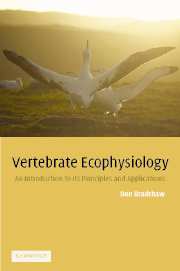Book contents
- Frontmatter
- Contents
- Introduction
- 1 Homeostasis: a fundamental organising paradigm in ecophysiology
- 2 Stress: the concept and the reality
- 3 Basic methods used in ecophysiological studies
- 4 Turnover methodology: theory and practice
- 5 Case studies of stress: incidence and intensity
- 6 Survival in deserts
- 7 Torpor and hibernation in cold climates
- 8 Marine birds and mammals
- 9 Conclusion
- Appendix 1 Population estimation methods
- Appendix 2 Estimation of food intake in Tiliqua rugosa
- Appendix 3 Simultaneous measurement of sodium and potassium concentration in plasma or urine using the IL 143 digital flame photometer
- Appendix 4 Determination of plasma urea nitrogen
- Appendix 5 Radioimmunoassay of testosterone in plasma
- Appendix 6 Preparation of ‘stripped plasma’
- Appendix 7 Radioimmunoassay of testosterone in faeces
- Appendix 8 The comparative method
- Appendix 9 Basic turnover equations
- References
- Index
6 - Survival in deserts
Published online by Cambridge University Press: 05 June 2012
- Frontmatter
- Contents
- Introduction
- 1 Homeostasis: a fundamental organising paradigm in ecophysiology
- 2 Stress: the concept and the reality
- 3 Basic methods used in ecophysiological studies
- 4 Turnover methodology: theory and practice
- 5 Case studies of stress: incidence and intensity
- 6 Survival in deserts
- 7 Torpor and hibernation in cold climates
- 8 Marine birds and mammals
- 9 Conclusion
- Appendix 1 Population estimation methods
- Appendix 2 Estimation of food intake in Tiliqua rugosa
- Appendix 3 Simultaneous measurement of sodium and potassium concentration in plasma or urine using the IL 143 digital flame photometer
- Appendix 4 Determination of plasma urea nitrogen
- Appendix 5 Radioimmunoassay of testosterone in plasma
- Appendix 6 Preparation of ‘stripped plasma’
- Appendix 7 Radioimmunoassay of testosterone in faeces
- Appendix 8 The comparative method
- Appendix 9 Basic turnover equations
- References
- Index
Summary
The desert environment is one traditionally viewed as being ‘inhospitable’ from an anthropomorphic (i.e. human) point of view. Many vertebrate animals, however, live and reproduce there successfully and the study of the many adaptations – morphological, physiological and behavioural – that make this a possibility has occupied comparative physiologists and ecophysiologists for decades. Every continent of the world contains a desert, including the Arctic and the Antarctic, which are classified as semi-arid deserts, and it is of interest to note, as shown in Figure 6.1, that the world's deserts include large areas of the ocean adjacent to each continent. The major physiographic and environmental characteristics of the world's deserts, both hot and cold, have been summarised by Bradshaw (1986) and interesting rainfall comparisons in terms of predictability and constancy (as defined by Colwell, 1974) are given by Low (1978), showing that the Australian deserts have the lowest probability of rainfall. Soil fertility is another important factor limiting productivity in arid situations; Figure 6.2 compares nitrogen and phosphorus concentrations in soils from various parts of the world, those of South Africa and Australia being by far the least fertile and therefore expected to have the lowest productivity (Stafford Smith and Morton, 1990).
- Type
- Chapter
- Information
- Vertebrate EcophysiologyAn Introduction to its Principles and Applications, pp. 102 - 165Publisher: Cambridge University PressPrint publication year: 2003



